Tanunda
J.C.A. Kruger. Hochkirch (Tarrington) Victoria, 1863
1 manual, 8 speaking stops, mechanical action, foot-blown
Man: 8.8.8.8.4.4.4.2.
The organ was built in 1863 by J.C.A. Kruger for St Michael's Lutheran Church, Hochkirch (Tarrington), Victoria. It was removed in about 1929 and used in a private residence in Ballarat. The organ was restored and installed in its present location in 1997 by Roger Jones (Nuriootpa). This organ is a rare example of the Silbermann-style positiv organs built in Australia by German expatriates.
The Museum is in the old Tanunda Post Office.
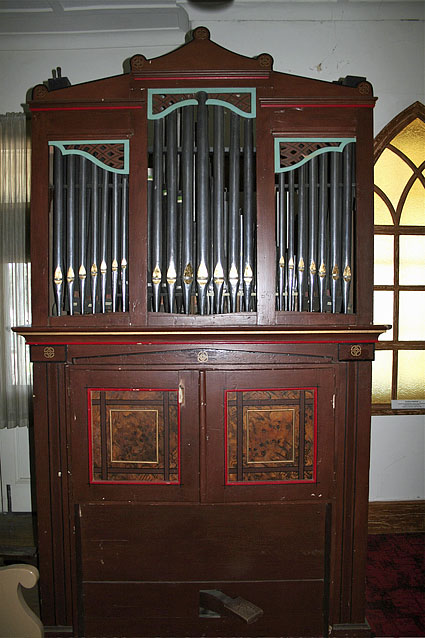
The specification is:
| Manual Left Jamb Gedeckt Spitzflote Flotenoktave 2 Ft Bass Right jamb Prinzipal, Oktave Dulciana Viole |
8 4 4 - 8 4 8 8 |
Both the 2 Ft Bass and Viole 8 are smaller stop knobs to the others, suggesting changes from original.
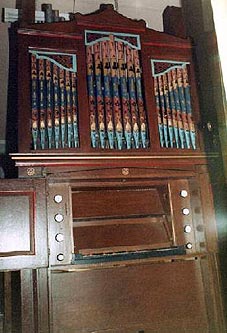
Before restoration.
From
the 2009 OHTA Conference Book,
David Shield writes:
The
organ currently in the Museum in Tanunda is recognised as the second organ
built by J.C.A. Krüger. The
involvement of Krüger’s descendents helps identify the instrument though the
date of its construction is unclear.
After its initial deployment with the church at Hochkirch (later named
Tarrington) in Victoria, and use as a residence organ, it had a somewhat
turbulent history before finding its current location.
J.C.A.
Krüger arrived in Western Victoria in mid 1855 from South Australia.1 His eldest son Carl and members of the
extended family had arrived four years earlier. They settled to farming at Hochkirch with land later at Lake
Linlithgow near Hamilton. Kruger
died in 1871 and is buried in the Tabor cemetery.
The
first church building in Hochkirch was erected in 1854 about a mile east of
Hamilton. A simple wattle and daub
construction with thatched roof it served the dual purpose of church and
school. A second building replaced
it in 1858, four miles further east, and a third in 1863. The latter was a far more substantial
structure measuring 53 feet by 26 feet, of bluestone, with wood shingle roof,
costing £700 and dedicated on 18 August 1863. The seating capacity of even this building was quickly stretched
and it was eventually relaced with the current building dedicated on 1 January
1928.2
It
is not clear when, or for which church building, Krüger made the organ. Even the family history is
confused. At one point it states: “whilst
at Hochkirch J.C.A. built an organ for the first church. The church was built in 1863 … and named St Michael’s.”3 This ignores the existence of the two
former church buildings. Assuming
the date to be in error this would allow for construction between Krüger’s
arrival late in 1855, and 1858 when the second church was built. In 1863, Krüger would have been aged
63. However, the organ was then
said to have been built “in about 1863 … of local hand carved timber and contained 260 pipes of wood and
metal”. “Purchased by the
congregation for £80” it was “in
constant use for 65 years in the first and second churches, till it was
replaced in 1928”.4
Clearly for this statement to be correct either the organ was built for
the third church and was not in either the first or second churches, or the
organ may have been built for, and served in, the second church as well as the
third. It again ignores the
existence of the 1854 building.
Notwithstanding
the uncertainty of when it was built, the organ remained in St Michael’s until
1927. At this point the Krüger
organ became redundant with a new instrument from George Fincham & Sons of
Melbourne taking its place in the new church. The active involvement of Krüger’s
descendants has helped preserve this instrument. J.C.A.’s son Carl who was also a competent organist, and
flowed through to his children in Friedrich Reinhold, who became an organ and
piano tuner in the Wimmera District of Victoria, and Christian Paul, who was
also a talented musician, shared the love of music. Known by his second name, Paul, it was he who took a
particular interest in his grandfather’s organ. It would appear from the family record that when the organ
became redundant in 1928 the congregation of St Michael’s donated the
instrument to Paul who retained it in his residence, perhaps till his death in
1965.5
The
sequence of events over the next two decades is not clear. It would seem that the organ came into
the possession of a Mr Winkler of Ballarat and became a centre of
controversy. The Krüger family
wished to buy the instrument back, but Mr Winkler was not inclined to sell or
even communicate with the Krüger family.6 Nevertheless by 1980 the organ was to be found in the barn
of Brian Nagorka of Penshurst, a descendant of Krüger (through his second son
Gustav)7, and incidentally neighbour to OHTA member Tony
Wilson. There the parts were
systematically sorted in his barn and fully documented by John Stiller”.8 Ownership now resided with the Krüger
Family Trust.
Between
1981 and 1985 the organ was restored.
Initially Doug Price of Geelong rounded out the metal pipework and
renovated the pallet pull down mechanism.
The work was then handed over and completed by Leighton and Sheila Turner
of Ballarat. The diagonal bellows
and feeder were re-leathered; the windchest and action were fully refurbished
and missing sections of casework replaced. The diapering of the pipes and overall scheme of decoration
was restored by Sheila and the stop names and labels reconstructed by Leighton.9 A new home was found for the organ in
the gymnasium of the Good Shepherd Lutheran College Hamilton.
In
April of 1986 a review by Tony Wilson found the restoration wanting. Although the appearance of the casework
was regarded as superb and a credit to the restorers he found several of the
stops to be unsatisfactory and suggested serious problems with the
soundboard. In their right of
reply, Leighton Turner commented that the soundboard was satisfactory but admitted
they had had to rectify a problem in the upperboards where the borings had run
too close. A few pull-down hooks
also had to be eased, a problem not of their making and not considered serious
enough to rectify. Wilson also
felt that because of previous alterations it was difficult to determine the
original nature of the instrument.
The Turners disagreed, considering it to be “very close to its original
construction”. Because of its
location in the school environment Wilson suggested the desirability of adding
a good silent electric blower and expressed his disappointment that it did not
find a home in its original site.10
Perhaps
the potential for damage was recognised.
By 1989 Pastor Mark Whitfield, then at Tarrington, had it removed and
brought back to the manse. After
consultation with some of Krüger’s descendants and their subsequent agreement,
the organ was brought to the Barossa Valley where it was kept until it could be
restored in 1997 and relocated to the Tanunda Museum.
The
restoration undertaken by Roger Jones at Tanunda appears to have been of
minimal proportions. The case had been cut down at its base for several inches
which affected the rise of the bellows.
This was rectified. Several
missing pipes were replaced with new ones. Perhaps the main change has been the removal of the
intricate diapering undertaken by Sheila Turner. Apparently the pipes were so dented that the painted pattern
had become so distorted that it necessitated complete removal. The façade pipes are now polished bare
metal.11
The
specification of the organ in its current state is a follows:
J.C.A Krüger
1 manual, 8 speaking stops, mechanical action
MANUAL
|
Left
jamb |
|
|
Right
jamb |
|
|
Gedekt
(wood) |
8 49 pipes |
|
Prinzipal
(metal) |
8 37 pipes |
|
Spitzflöte
(metal tapered) |
4 37 pipes |
|
Oktave
(metal) |
4 49 pipes |
|
Flötenoktave
(open wood) |
4 25 pipes |
|
Dulciana
(spotted metal) |
8 37 pipes |
|
2
ft Bass (metal to TB) |
2 24 pipes |
|
Viole |
8 25 pipes |
Compass C-c 49 notes 283
pipes
Console en fenêtre, with folding doors
Wind indicator; diagonal
feeders; foot blowing for performer or assistant
Note that the stop names
are hypothetical
1 Reference to Krüger
should be read in conjunction with the organs at Bethany and Stockwell.
3 Krüger Family
Committee, Johann Carl August Krüger and his descendants in Australia
1848-1980 1981, p.13
4 Ibid, p.21; repeated from Naylor, B.A., Organ
Building in South Australia (unpublished
thesis M Mus, University of Adelaide 1973), p.102, who in turn sourced his
information from the pamphlet, Tarrington Centenary 1853-1953 published by St Michael’s Lutheran Church,
Tarrington, Victoria. The
confusion in buildings is repeated in Lutz M., The Work Praises the Man 1996, p.11, and Lutz, M., ‘Krüger’s Last Organ –
Tarrington’, OHTA News, vol 22,
no1 (January 1998), p.36
5 Krüger Family Committee
op.cit., p.64
6 Naylor op cit p.102; according to a letter from John Maidment to
Bruce Naylor dated 22 April 1970, Mrs Sophie Mirtschen, also a Krüger
descendant (Krüger Family Committee op.cit. p.65) had sought to obtain the specifications of the organ from Mr
Winkler to no avail.
7 Krüger Family
Committee, op.cit. p.93
8 Maidment, John, ‘J.C.A. Krüger and the
Restoration of his Hochkirch Organ’, OHTA News, vol.9
no.2 (April 1985), p.15; John Stiller Documentation no 28
9 Maidment, John, op.cit.
10 Wilson Tony ‘The Carl
Krüger Organ, Hochkirk 1863’, Victorian Organ Journal (August 1986), pp. 3-4; ibid Turner, L. comment, p.6
11 Lutz M., op.cit., January
1998, pp.36-38
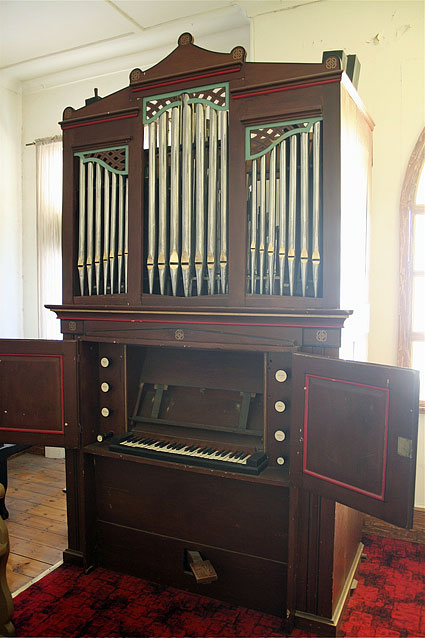
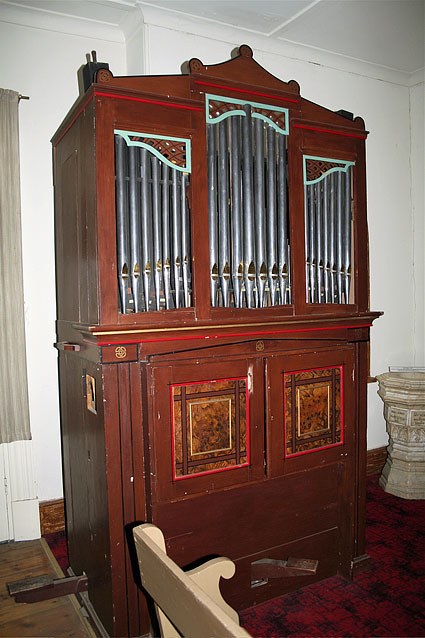
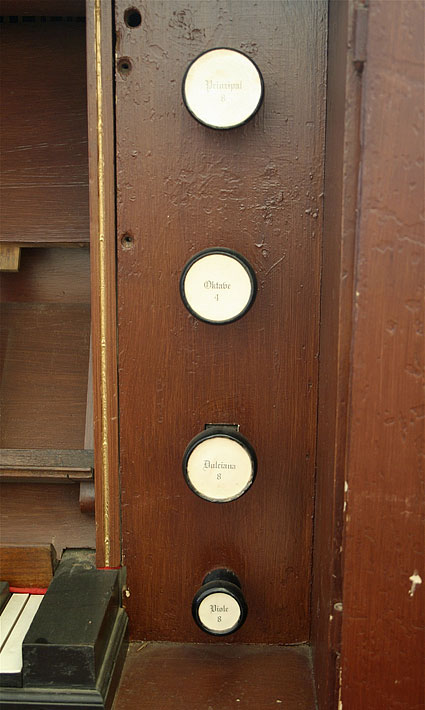
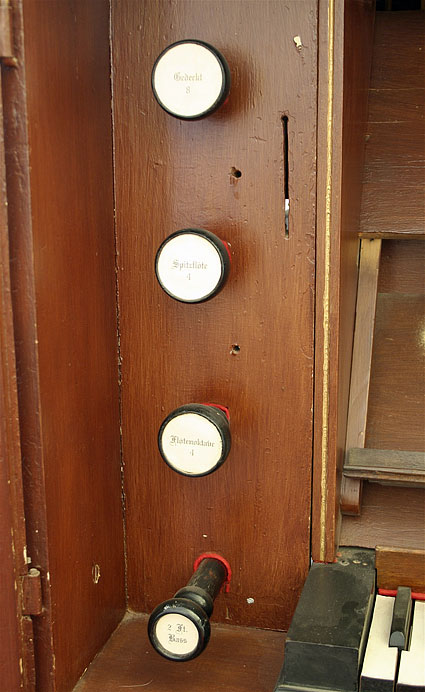

Photos: Trevor Bunning (March 2009)
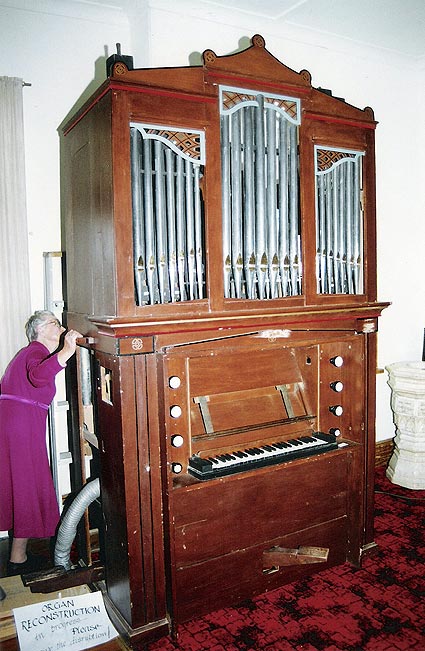
Photo: Trevor Bunning
(Trevor's mother is inspecting the organ)